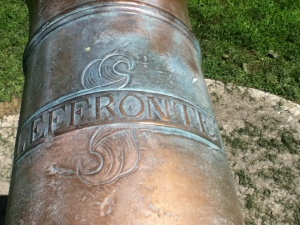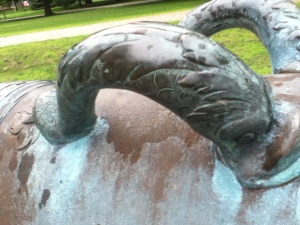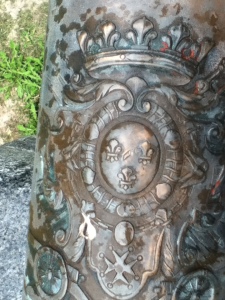The end of the school year and some travels after that have left me with no time to write anything on this blog. I’m sure the scores of adoring readers out there have been infinitely disappointed over the past three months (that is sarcasm, by the way, in case anyone is in doubt)! But my travels did put me in contact with a very interesting cannon in Galesburg, Illinois. On the grounds of the Knox County Courthouse sits a muzzle-loading, bronze cannon placed atop a stone base shaped like a carriage, which reads “CAPTURED AT SANTIAGO 1898,” during the Spanish-American War. However, at the time, a bronze muzzle-loader was already made obsolete by such innovations as breech loading and steel construction, which had made artillery devastatingly effective. So what was an apparently useless cannon doing in Cuba? And how did it end up in Galesburg—a town of about 30,000, the site of one of the Lincoln-Douglas debates, and hometown of poet Carl Sandburg?
Closer inspection revealed the gun to be decorated ornately. Near the muzzle, on the chase, it is marked “L’Effronté.” Then a motto, “Ultima Ratio Regum.” Below that reads “Louis-Charles de Bourbon, Comte d’Eu, Duc d’Aumale” and a coat of arms. The lifting handles come in the shape of dolphins.
On the reinforce, near the trunnions, is stamped “DE” followed by a figure that looks like a circle with a triangle facing point-down on top of the circle. Then another motto, “Pluribus Nec Impar.” This is followed by an image of a radiant sun and a second coat of arms with fleurs-de-lis. Finally, the cascabel is fashioned into a dragon and around the base ring is inscribed, “Berenger Donincourt fecit Duaci 25 Martii 1741.”
So I set about researching the various imagery, phrases, and people inscribed on the cannon. Starting near the muzzle, on the chase, “L’Effronté” is the title of the gun, meaning “Insolence.” The naming of guns was a common practice in 17th- and 18th-century France. Some guns even had quite bizarre names, such as “Le Nasillard,” the one who speaks nasally. The motto “Ultima Ratio Regum” is Latin for “The Last Argument of Kings.” This motto had first been engraved on French cannons during the reign of Louis XIV (1643-1715).
Then there is the name of a nobleman from the House of Bourbon: Louis-Charles de Bourbon, whose titles on the cannon include Comte d’Eu and Duc d’Aumale. Louis-Charles’ father was Louis-Auguste, the son of King Louis XIV and his mistress. Louis-Auguste held the post of Grand-Maître de l’Artillerie (Grand Master of Artillery), who was responsible for the production of artillery, ammunition, and powder, as well as for the administration of arsenals. The Grand-Maître de l’Artillerie also served as the commander of the royal artillery regiment.1 Louis-Charles was born in 1701, and in 1710 Louis-Auguste passed the position onto his son, who presumably was only nominally in charge as a 9 year old!2 Louis-Charles held the post until 1755, when the position itself was suppressed by King Louis XV. The coat of arms below Louis-Charles’ name features a crown, fleurs-de-lis on a shield, and cannons.

Detail of a cannon from the coat of arms for Louis-Charles de Bourbon, signifying his position as Grand-Maître de l’Artillerie.
The reinforce of the cannon features symbols of the Bourbon monarch, who was, at that time, Louis XV. The phrase “Pluribus Nec Impar” is emblazoned above the sun symbol. The phrase itself means “To Many Not Unequal,” but it requires a little elucidation. King Louis XIV took it as a motto, and wrote that it meant that he would not be unequal to the task of ruling other empires as the sun was not unequal to illuminating other worlds.3
Engraved above this Latin phrase are the letters “DE” and the figure of a circle with a triangle, point-down, on top. I’m not sure what this is, though I suspect it also indicates the caliber. Anyone who is more knowledgeable can certainly weigh in and clarify.
Around the base ring of the cannon is engraved the founder, the place where the cannon was made, and the date it was cast: “Bérenger-Donicourt made [this cannon] at Douai on the 25th of March, 1741.” Bérenger-Donicourt is the name of the gun founder. François-Simon Bérenger-Donicourt was commissioner ordinary at the foundry at Douai from 1739 until his death in 1747.4 Douai, in northeastern France, had been the location of a royal foundry since the reign of Louis XIV; guns continued to be manufactured in the town until the period of World War I.
Finally, the cascabel features a dragon. In the early 18th century, Jean Florent, Marquis de Vallière and Lieutenant General of the Artillery and Armies of the King, standardized guns by caliber. Caliber was indicated by the representation on the cascabel: 24-pounders, a lion with a mace in the mouth; 16-pounders, a Medusa with torch in mouth; 12-pounders, a rooster; 8-pounders, a dragon; and 4-pounders, a lion with mace again (the sizes of 24- and 4-pounders would be so great that there would not be any confusion). L’Effronté hurled 8 pound projectiles.
This is the first of two posts in which I will explore this cannon, its markings, and where it came from. Partially, this was an exercise in extracting as much information from this artifact as possible; it was very instructive for me, as I learned a lot about weapons production and army organization in Bourbon France. I also found many resources on military history in general and cannons in particular that I will no doubt refer to often in the future.
1John A. Lynn II, Giant of the Grand Siècle: The French Army, 1610-1715 (1997): 99-100.
2M.A.-L. d’Harmonville (ed.), Dictionnaire des Dates, des Faits, des Lieux et des Hommes Historiques; ou les Tables de l’Histoire, vol. 1 (1842): 273.
3Memoirs for the Instruction of the Dauphin, trans. and ed. P. Sonnino (1970 (1661)): 104.
4 A. de Ternas, Généalogie des Bérenger, commissaires ordinaires des Fontes de l’Artillerie à Douai, de 1695 à 1820, in Souvenirs de la Flandre-Wallonne, vol. 7 (1867): 51.










Thank you for these two excellent articles. The cannons could have come of French ships captured during one of the eighteenth century wars between France and Spain or simply bought by Spain during time of peace. There are a couple of French cannons of later date (1774) at Fort Leavenworth, which also seem to be Spanish-American War trophies. They are a lot less decorative..
I am currently trying to trace the cannons originally at Fort de Chartres (Illinois, near Prairie du Rocher, about forty miles south of St. Louis)
I appreciate your comment, I’m glad you enjoyed the posts. It’s definitely possible that the cannons were captured or peaceably bought. I wonder what records, if any, exist of specific guns like l’Effronte, which might detail where they were deployed. If any such documents exist, they are probably buried in the Bibliotheque nationale de France.
The 1902 Report of the Chief of Ordnance of the U.S. Army is valuable for where these war trophies ended up once in America. Fortunately it is available on Google Books: http://books.google.com/books?id=6zM-AQAAMAAJ&num=10. I am sure that it lists the Fort Leavenworth cannons.
Your research on Fort de Chartres sounds fantastic, and I hope to hear about it–perhaps you could even guest write on here!
I would like to do that, though my work is still incomplete. Some cannons from the old French Fort de Chartres went after 1765 to St. Louis, to St. Genevieve, to Fort Russell during the War of 1812, and to Fort Jefferson in Kentucky in 1780. There are still a lot of holes in the story, but at least some of the account is beginning to come together.
On the reinforce, near the trunnions, is stamped “DE” followed by a figure that looks like a circle with a triangle facing point-down on top of the circle.
It means that the gun is a 8 pounder, or “de a 8 libras” in spanish.
In Morro Castle in Santiago de Cuba there are 2 of these guns, DE 24.
In El Caney monument, at El Viso fort, there are another DE 24 (Cuba)
In the monumet of McCalla Hill in Gitmo Naval Station in Cuba, there are another DE 24.
In Presidio , California, there are another DE 24.
In some sources I can read that the general Sahfter took about 15 of these french guns (Valliere system) from Santiago as a trophys. I are very glad surprised when I found in your website these gun in Illinois, is the first 8 pounder from Santiago that I know. ¿you know of some other gun of its kind in the USA ?
Sorry for my bad english
Hi, Pedro! Thank you for your comment, and no need to apologize for your English; it is very good!
I know that there are several of these captured guns in the U.S. The report “Annual Reports of the War Department for the Fiscal Year Ended June 30, 1901: Report of the Chief of Ordnance” from 1902 has a record of these guns and where they went. You can find it on Google Books (http://books.google.com/books?id=6zM-AQAAMAAJ&pg=PA81&lpg=PA81&dq=l%27effronte+cannon&source=bl&ots=ZcBZgi5urr&sig=mLgaUdZet8MnG6o2MIYHBBHTp2Q&hl=en&sa=X&ei=ymR6VPnEGsjfsATHqYL4DQ&ved=0CDIQ6AEwAw#v=onepage&q&f=false). Unfortunately it does not list the guns by the weight of their projectiles, so I can’t say how many 8-pounders there were taken during the Spanish-American War.
The correct marking is DE 8 which stands for canon de 8, or 8 pounder. You had guessed correctly that this is an 8 pounder, the marking confirms it. This is a typical cannon of the ordonnance de 1732. Valliere kept the 5 calibers previously in use (4, 8, 12, 16 and 24 pdr) but standardized the external dimensions across all foundries of the kingdom to facilitate the replacement of carriages when needed. The complete standardisation of all artillery equipment was only achieved some time later through the Gribeauval system.
Thank you!
Other interesting markings to notice are the ones on the trunnions. The right one normally gives the weight in French pounds. A typical indication for such an 8 pounder could be 2100 L. The left one normally gives a sequence number, corresponding to the series of cannon produced at the given foundry (Douai in your particular case)
That’s very interesting, I did not know that. Thanks! I will be on the lookout for such markings in the future.